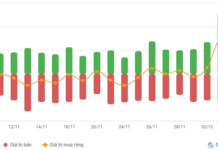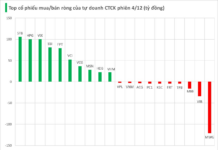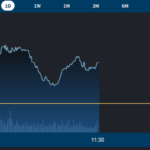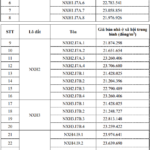Stopping Violations at Their Source
The State Securities Commission of Vietnam has recently imposed administrative sanctions on 23 individuals for lending their accounts for securities trading, which led to market manipulation violations involving the shares of GKM (GKM Holdings Joint Stock Company). Prior to this, in August 2024, the Investigation Police Agency of Hanoi decided to initiate legal proceedings and prosecute seven individuals for manipulating the stock market for CMS shares of CMH Vietnam Joint Stock Company. This case took place from May 2023 to May 2024, following the exposure of large-scale scandals involving Trinh Van Quyet and Do Thanh Nhan.
Occasionally, individuals are fined by the State Securities Commission, ranging from a few hundred million to a few billion VND, for violations related to stock manipulation. These fines, however, do not reach the level of criminal prosecution.
Additionally, there have been instances of stocks hitting the daily limit-up or limit-down prices for several consecutive sessions, leaving investors and even the leaders of listed companies perplexed as to the reasons behind these abrupt moves. This has led many to perceive the stock market as a game of chance or a casino, where profits and losses are not derived from the intrinsic value of companies or the economy’s performance. Amid a downward market trend without apparent reasons, investors become convinced that there are “invisible hands” manipulating stock prices, forcing the market into the red and moving contrary to the overall domestic and international economic trends.
According to experts, to enhance market transparency and restore investor confidence, ensuring that the stock market truly reflects the health of the economy, additional tools are needed to detect and prevent violations. Associate Professor Dr. Nguyen Huu Huan from the University of Economics Ho Chi Minh City (UEH) suggested that the government should provide more educational programs to help investors understand that the stock market is an effective capital mobilization channel for the economy. Investors should aim for long-term participation and hold stocks to enjoy the income generated by companies, rather than engaging in short-term speculation, which is currently prevalent. Only then can the stock market develop sustainably and truly become a “barometer” of the economy, providing medium and long-term capital.
According to this expert, regulatory authorities need to continue enhancing market transparency by implementing regulations and supervisory mechanisms with a deterrent effect and the ability to detect anomalies. For instance, there should be a requirement to disclose securities trading order books to identify stocks that are being manipulated and orders that exhibit abnormal patterns. Disclosure of order books does not entail revealing the specific names of investors or their personal information; instead, it provides the market and independent research organizations with insights into the flow of capital and identifies stocks with unusual trading activities. “Big Data analytics and artificial intelligence (AI) can be leveraged by regulatory authorities to detect abnormal transactions, thereby identifying cases of insider trading, price manipulation, and market manipulation. With the vast number of transactions for each stock and the thousands of stocks in the market, it is challenging for a person to identify anomalies manually. However, by employing advanced technologies, abnormal transactions can be spotted, facilitating investigations and the detection of violations at their source, enabling effective prevention,” said Huan.
Additionally, experts concurred on a simple solution: large shareholders must disclose information. If they fail to do so, they should not be allowed to place orders, and the regulatory authority should not approve such buy or sell orders. Implementing these solutions would help restore investor confidence.

Vietnamese investors are increasingly anxious about the stock market’s performance. Photo: QUYNH TRAM
Has the Bottom Been Reached Yet?
Returning to the current stock market situation, on November 19, the VN-Index witnessed a sharp decline of nearly 12 points, falling close to the 1,200-point level. The sea of red among stocks left investors bewildered. Many investors who attempted to “catch the bottom” on November 18 suffered further losses.
Meanwhile, foreign investors continued their net selling spree, leaving local investors dismayed. In just the last three trading sessions, they net sold over VND3,500 billion, significantly impacting the sentiment of domestic investors. Many wondered if foreign investors were taking profits or exiting the market.
According to Nguyen Viet Duc, Director of Digital Business at VPBank Securities Joint Stock Company (VPBankS), the trading volume of foreign investors is currently quite low, accounting for only 8-9% of the total market trading volume. However, as investors consider the money of foreign investors as “smart money,” their continuous selling sprees cause anxiety among local investors. “The sentiment of investors is already quite low, and if foreign investors turn to net buying for just one to two weeks, the market’s trend will undoubtedly change,” said the expert.
Economist Dr. Nguyen Tri Hieu also noted that although foreign investors account for a small proportion of trading volume, they play a leading role in guiding capital flow trends. “Domestic investors are mostly small individual investors who lack financial and market knowledge and tend to trade stocks based on rumors and are easily influenced by herd mentality. When foreign investors net sell, domestic individual investors are significantly impacted,” said Hieu.
Chen Chia Ken, General Director of Phu Hung Securities Joint Stock Company, observed that the Vietnamese stock market currently faces some challenges, including liquidity issues and the circulation of capital in the economy. “The market currently lacks new investment options to meet the demands of foreign investors. This is partly due to limitations on foreign ownership ratios, and the divestment of state capital from large enterprises remains unfinished. Capital inflows from domestic individual investors into the stock market are not as robust as before,” said Chen Chia Ken.
Attracting More Institutional Investors
One of the issues that experts believe needs to be addressed is the market’s investor structure. Currently, most of the daily transactions on the stock market come from individual investors. This type of capital is sensitive to information and easily influenced by emotions. The fact that the VN-Index has repeatedly failed to surpass the psychological threshold of 1,300 points also indicates that investors tend to seek profit-taking opportunities when the index approaches this level, creating an obstacle to the market’s breakthrough.
Chen Chia Ken pointed out that the number of institutional investor accounts remains modest. Mutual funds and exchange-traded funds (ETFs) have not yet gained widespread popularity among the general public in Vietnam, despite their growing scale and number compared to previous years.
The Ever-Rising Bridge, a Lush Green Electrical Panel
Although the VN-Index only gained a modest 3.24 points (+0.25%) by the end of the morning session, the index traded above the reference level for most of the day. This upward movement was driven by a strong buying force, indicating investors’ willingness to accept higher prices. Blue-chip stocks took the lead, not only pushing the index up but also accounting for over half of the market’s liquidity.
The New Push for Corporate Bond Market
The Vietnamese corporate bond market has been on a notable recovery path since the crisis in 2022 and the first half of 2023. While it aims to become a long-term capital mobilization channel, sharing the burden with the banking system, there are numerous aspects of the corporate bond market that need improvement. A key catalyst for the market’s future growth is considered to be credit ratings.
Securities Authorities Charge Seven in Scheme to Manipulate CMS Stock
To manipulate the price of CMS stock, the group led by Tran Binh Minh employed multiple securities accounts to buy and sell the CMS stock. They aimed to create a false sense of liquidity and volume, enticing unsuspecting investors to join the scheme. This orchestrated effort allowed the group to control the stock’s price movement, creating an illusion of stability and potential growth.









































